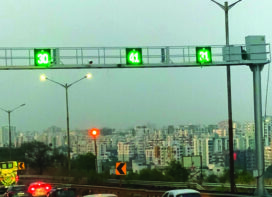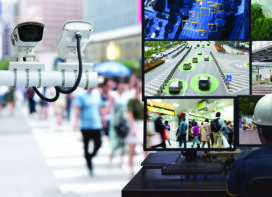 Forecasting traffic is a very important tool of traffic management. It is done by using mathematical models of traffic flow and the result is then used to predict congestion, plan amelioration and establish future usage levels of the mitigating measures. The measures can include simple and low-cost traffic signals to complex and expensive bridges across the ocean (and everything in between). While it is easy to see how traffic flow is related to increasing population, burgeoning number of cars and narrow roads, it is not so easy to put all this together using school algebra. It is for this reason that we rely on specialist personnel called traffic modellers who use sophisticated computers and software to solve this knotty problem. Needless to say, these specialists using sophisticated measures prove to be expensive.
Forecasting traffic is a very important tool of traffic management. It is done by using mathematical models of traffic flow and the result is then used to predict congestion, plan amelioration and establish future usage levels of the mitigating measures. The measures can include simple and low-cost traffic signals to complex and expensive bridges across the ocean (and everything in between). While it is easy to see how traffic flow is related to increasing population, burgeoning number of cars and narrow roads, it is not so easy to put all this together using school algebra. It is for this reason that we rely on specialist personnel called traffic modellers who use sophisticated computers and software to solve this knotty problem. Needless to say, these specialists using sophisticated measures prove to be expensive.
While we in India produce world class traffic planners and modellers from our institutes, the usage of world class computers and software is less prevalent, mainly due to the prohibitive costs. The fact is that we do not make any of these but, once in a while, buy the obscenely expensive ones from abroad. Most urban local bodies that need this expertise cannot afford the expensive tools. Therefore, it remains a stranglehold of few consulting companies and academic institutes. It is for this reason that India is behind most of the rest of the world in this area. The fact that our traffic is more complex than most of the rest of the world, does not make it easier. It is not difficult to see why modelling a mix of vehicles is more difficult than modelling a simple stream of cars where these tools are created – in Europe, North America and Australia.
Garbage in – garbage out
 Also, as with any other problem which is attempted to be solved through computers, the task of traffic modelling depends a lot on the quality of the inputs. A variety of inputs are required and that too, in large quantities. First comes the demography: How many people, what vehicles they own, where do they work, how do they go about doing their daily business, how much do they earn, how much are they ready to spend on travel, etc., are some of the basic questions that need to be answered. Then comes the wherewithal: Traffic facilities such as roads, junctions, terminals, buses, trains, etc.
Also, as with any other problem which is attempted to be solved through computers, the task of traffic modelling depends a lot on the quality of the inputs. A variety of inputs are required and that too, in large quantities. First comes the demography: How many people, what vehicles they own, where do they work, how do they go about doing their daily business, how much do they earn, how much are they ready to spend on travel, etc., are some of the basic questions that need to be answered. Then comes the wherewithal: Traffic facilities such as roads, junctions, terminals, buses, trains, etc.
And last but not the least, and this is where things become tricky, we need data on our own travel behaviour. We know congestion slows us down but we do not exactly know how much, how fast or how slow. We know a new and expensive rail link will reduce congestion on the road but we do not exactly know how much and how quickly. Many such issues demand looking into and then, finding solutions.
Lack of detail
Since the problem is multi-dimensional and complex, it is impossible to talk about it in a comprehensive manner in this article. It is better to pick up and discuss a small part of the problem, but a particularly sore part.
The most concerning issue in the Indian traffic modelling environment today is the lack of detail. Most of the traffic modelling being done is at a very small scale, largely for a whole city or a conurbation. These plans tend to be very strategic in nature with a horizon of 20 years or more. Therefore, they often blue-sky the input parameters (demographic, economic and land use). The road network used in these models is mostly defined in terms of major links and their traffic carrying capacity. In the process, the kind of rosy pictures these studies paint are also, at best, blue sky thinking. This is not entirely bad as we do need rosy pictures / visions to base our plans upon.
But there is a complete lack of capacity for traffic planning for small areas (large scale) where more detailed and precise solutions need to be generated. A particular area where precision or predictive power of traffic models is lacking is the modelling of a traffic junction – the traffic light, the chauraha, the chowk or whatever you want to call it. Since junctions are the places where the lion’s share of journey time is consumed, it is important that their working is better understood. A predictive capability of a traffic model vis-a-vis junctions makes it more amenable for the generation of short and medium term solutions. It is precisely because of this lack of understanding (or lack of desire to put the effort required) that most plans tend to leap-frog to more expensive but ad-hoc solutions such as grade-separations (flyovers) and elevated roadways.
The problem of junctions has its many facets too such as suitability, design, frequency, etc. And as with the case of overall traffic modelling, it is not possible to talk about all of these in sufficient details here. So again, it is better to pick a part of the problem – a part which troubles the task of traffic modelling most – predicting the delay experienced at the junctions.
Details at the junctions
As has been discussed earlier, in order to get our traffic models right, it is important to predict the travel times correctly. We also discussed how in the urban areas, most of the travel time is made up of delays at the junctions. There are five levels of details which a modeller can opt for depending upon how accurate s/he wants to be about this part of the journey time.
1. Consider junction delay to be part of the time spent travelling on the road
2. Assume fixed delays for various types of junctions and of their turning movements
3. Relate delay of a turning movement with the amount of traffic on that movement
4. Relate delay of a turning movement with the amount of traffic on all the turning movements of the junction
5. Micro-simulation
Some details on these points are as follows:
Consider it to be part of the time spent travelling on the road: This strategy almost amounts to ignorance. With this strategy, a modeller only bothers with predicting the delays while travelling on the road and assumes that this delay also approximates the delay experienced on the oncoming junction (See Sketch 1).
This is not all bad because this is what one has to do if the area being modelled is large (hundreds of square kilometers) with several millions of inhabitants and hundreds of kilometers of roads. If this is the scale at which a modeller is working then it is alright to ignore the junction delays, approximate the same with road journey times and concentrate on the big picture. But increasingly, this is done for smaller areas as well and this is what leads to wrong forecasts and faulty planning.
 TrafficInfraTech Magazine Linking People Places & Progress
TrafficInfraTech Magazine Linking People Places & Progress


